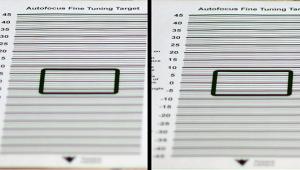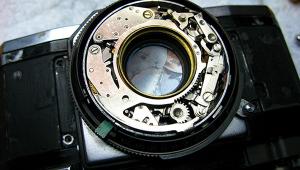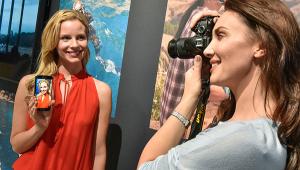Technically Speaking: What a Camera of the Future Might Look Like

Photo courtesy of photokina
Everyone hankers for a better camera, and that’s good news for equipment manufacturers. But is there an end point to this pining? Is there some camera that would be as good as it’s ever going to get?
Imagine a camera you could plunk down in front of the Taj Mahal or anywhere else and snap photos that were indistinguishable from reality. A camera producing images that, when properly displayed, would be pictorially the same as being there.
This kit would match your visual system in terms of resolution, field of view, dynamic range, and color gamut. And, of course, it would shoot in 3D. The Ulticam.
Could we ever build such a thing? And if so, when can you buy it?
Let’s do the numbers, starting with everyone’s favorite specification: resolution. We can reckon how many pixels Ulticam needs by noting that, unless you’re a hawk, the smallest detail your eye sees is about one-half minute of arc. That’s the apparent width of a dime at 400 feet. Mind you, you don’t have this kind of acuity over your entire retina, only the central fovea. But if someone’s looking at your photos on a souped-up Flickr of the future, who knows what part of the shot will attract their interest?
As an aside, if you have a 50-inch, high-def television, the acuity cited above will match the pixel size at a viewing distance of 13 feet. Closer, and you start to see those pixels. Farther away, you’ve wasted money.
We now pause to consider field of view, which in humans extends approximately 180 degrees horizontally and 135 degrees top to bottom. You don’t have full stereo vision over all of that, because much of the field is visible only to one eye or the other. But this is Ulticam, so why skimp? Imaging the full field of view at the maximum (half minute of arc) resolution requires 21,600x16,200 pixels, or 350 megapixels. That’s roughly 10 times more than you have now.
Ok, dynamic range: the brightness ratio of the lightest and darkest pixels in your pic. Your eyes have a range of about 100,000 to 1—think of looking into the sun and still seeing stuff in the shadows, an ability that no doubt helped our ancestors catch dinner. That greatly outclasses paper prints, which are about 100 to 1, or a living room TV, which is a few thousand to one (you don’t use sunglasses to watch TV, unless you’re really cool).
HDR, or High Dynamic Range, is poised to be the next big thing for television. But for Ulticam, we need the ultimate big thing, which means 17-bit deep pixels. If we have that number of bits for each of the red, green, and blue photosensors, not only can you photograph shade and sunshine simultaneously, but you also get two thousand trillion different colors. That should be adequate even for Ulticam, although the performance of the photosensors will affect the color gamut somewhat.
So what does Ulticam look like? The main point is that it has a 350-megapixel sensor, with each pixel being 17 bits in depth for each primary color. And you should double all numbers for 3D. An uncompressed image would be 4.5 gigabytes in size, although of course you could use .jpg or some other scheme to greatly slim that down, and avoid drowning your flash card.
Mind you, in determining these characteristics, we tried to match your eye. And that’s the right thing to do. You could put any sort of lens, say a telephoto, on Ulticam, to see a close-up of the Taj Mahal with the kind of pictorial fidelity you’d experience with high-quality binoculars.
Is Ulticam a pipe dream? Well, in the last 15 years, DSLR cameras have increased in pixel count by about a factor of seven. As in all things digital, improvement tends to be exponential with time. If so, then someone could build an Ulticam by the year 2035.
Meanwhile, you can mimic some of its performance by stitching together 10 photos from your camera. You might not be able to display it with full glory yet, but the artiste in you may be impressed.

Seth Shostak is an astronomer at the SETI Institute who thinks photography is one of humanity’s greatest inventions. His photos have been used in countless magazines and newspapers, and he occasionally tries to impress folks by noting that he built his first darkroom at age 11. You can find him on both Facebook and Twitter.
- Log in or register to post comments

















































